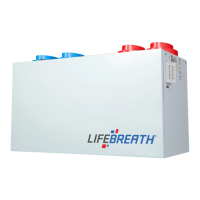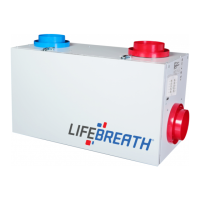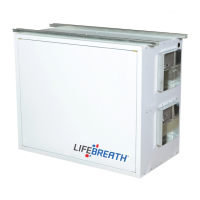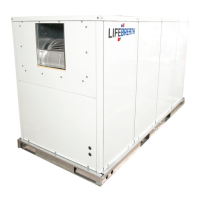Do you have a question about the Lifebreath RNC10 and is the answer not in the manual?
Guidance on choosing the appropriate ventilation rate for home comfort and personal preference.
Explanation of the dehumidistat function and its role in managing indoor humidity levels.
Definitions of terms and additional details relevant to HRV operation and features.
Details on the warranty coverage for Lifebreath RNC Series Heat Recovery Ventilators.
Overview of the advanced features offered by the Lifestyle RNC Digital Control unit.
Step-by-step instructions for configuring the digital control unit's settings.
Procedure for adjusting the dehumidistat setting on the digital control.
Explanation of the high-speed timer function for 20, 40, or 60 minute ventilation.
Details on using the continuous ventilation mode for consistent air exchange.
Information on the operational mode providing 20 minutes of ventilation per hour.
Description of the mode that alternates ventilation with air recirculation.
Explanation of the mode that recirculates indoor air without introducing fresh air.
Instructions for synchronizing the digital control's humidity setting with other devices.
Key features of the Lifestyle RNC Ventilation Control, including speed and dehumidistat.
Instructions on turning on, adjusting speed, and humidity control for the ventilation unit.
Information on the humidity control feature and how to set the dehumidistat.
Key features of the Lifestyle Dehumidistat, including its humidity measurement capability.
Instructions on how the dehumidistat works and how to set its desired humidity level.
Instructions for operating the 20/40/60 minute timer for high-speed ventilation override.
Instructions for operating the 20 minute timer for high-speed ventilation override.
Monthly inspection of exterior hoods for blockages and restrictions.
Procedure for cleaning the HRV's removable and washable air filters.
Instructions for cleaning the heat recovery core twice a year.
Note that motors are maintenance-free.
Annual inspection and cleaning of the HRV's condensate drain line.
Recommendations for cleaning accumulated dirt in ductwork.
Bi-annual cleaning of the unit's cabinet interior.
Procedure for cleaning the HRV's fan assemblies to prevent imbalance.
Details on port configuration options for the RNC95 unit.
Explanation of the round port's ability to be bent to an oval shape.
Description of the unique airflow path within the RNC95 unit.
Instructions for adjusting the high speed settings on the RNC200 model.
Instructions for adjusting the high speed settings on the RNC5-TPD model.
Diagrams showing dimensions for horizontal duct installation.
Diagrams showing dimensions for vertical duct installation.
Instructions and recommendations for suspending the HRV unit.
Guidelines for wall mounting the HRV unit using brackets.
Overview of the three primary installation methods for the HRV system.
Description of the simplified installation method for HRV systems.
Description of the partially dedicated installation method for HRV systems.
Description of the fully dedicated installation method for HRV systems.
Best practices for installing ductwork to maximize HRV efficiency.
Diagram and explanation of the simplified (Return/Return) installation method.
Important considerations for the simplified installation process.
Guidelines on sizing ductwork for optimal performance in simplified installations.
Information on the installation of spring-loaded backdraft dampers.
Additional installation notes specific to the simplified method.
Diagram and explanation of the partially dedicated installation method.
Important considerations for the partially dedicated installation process.
Guidelines on sizing ductwork for optimal performance in partially dedicated installations.
Information on the installation of spring-loaded backdraft dampers.
Additional installation notes specific to the partially dedicated method.
Diagram and explanation of the fully dedicated installation method.
Important considerations for the fully dedicated installation process.
Additional installation notes specific to the fully dedicated method.
Guidance on choosing a suitable and accessible location for installing the HRV unit.
Step-by-step instructions for safely suspending the HRV unit using provided straps.
Diagrams illustrating the horizontal installation of the HRV unit.
Diagrams illustrating the vertical installation of the HRV unit.
Instructions for wall mounting the HRV unit using 'L' brackets.
Steps for connecting the condensate drain lines for the HRV.
Guidelines for selecting and positioning grilles for optimal airflow.
Information on the Lifebreath Kitchen Grille, including its removable filter.
Details on the Lifebreath Techgrille for superior air distribution.
Instructions for installing the rough-in metal fitting before drywall.
Instructions for installing the stack head elbow fitting through walls.
Instructions for installing the quick mount fitting before drywall.
Instructions for installing fittings in ceiling tiles or finished drywall.
Guidelines for connecting ducting between weatherhoods and the HRV.
Requirements and placement guidelines for intake weatherhoods.
Requirements and placement guidelines for exhaust weatherhoods.
Overview of control components and preparation steps before mounting.
Steps for mounting the control unit to the wall.
Instructions for connecting the control unit's wiring.
How to operate timers and use the lockout mode function.
Instructions for installing mechanical timers and their wiring.
Ensuring the HRV operates in conjunction with the air handler or furnace blower.
Instructions for configuring the HRV to operate in standby mode.
How to operate the HRV using timers or dry contact controls without a main control.
Connecting dry contact controls for low speed, high speed, or dehumidistat functions.
Information on using Magnehelic gauges and digital manometers for airflow measurement.
Steps to take before performing the air balancing procedure.
Step-by-step guide for balancing airflow using a pitot tube.
Method for calculating airflow rates (cfm) after balancing.
Instructions for using door ports to measure and balance airflows.
Charts providing airflow data based on pressure readings for specific models.
Detailed airflow charts for RNC5-TPD models at different speed settings.
Information on factory-installed and required balancing dampers.
Description of available kits for airflow balancing.
Common causes and solutions for poor or restricted airflow.
Troubleshooting causes for cold supply air, including placement and temperature.
Solutions for when the dehumidistat is not functioning correctly.
Addressing high indoor humidity and window condensation issues.
Troubleshooting reasons for excessively low indoor humidity levels.
Resolving issues related to HRV frosting and problems with ductwork.
Solutions for water accumulation in the HRV, including drain pan and line problems.
Diagram of the electrical control panel and its components for the RNC120D.
Diagram of the electrical control panel and its components for multiple RNC models.
Diagram of the electrical control panel and its components for the RNC200.
Diagram of the electrical control panel and its components for the RNC5-TPD.
Section for the installing contractor to record unit and installation details.
Information and instructions for registering the product warranty.
| Brand | Lifebreath |
|---|---|
| Model | RNC10 |
| Category | Fan |
| Language | English |












